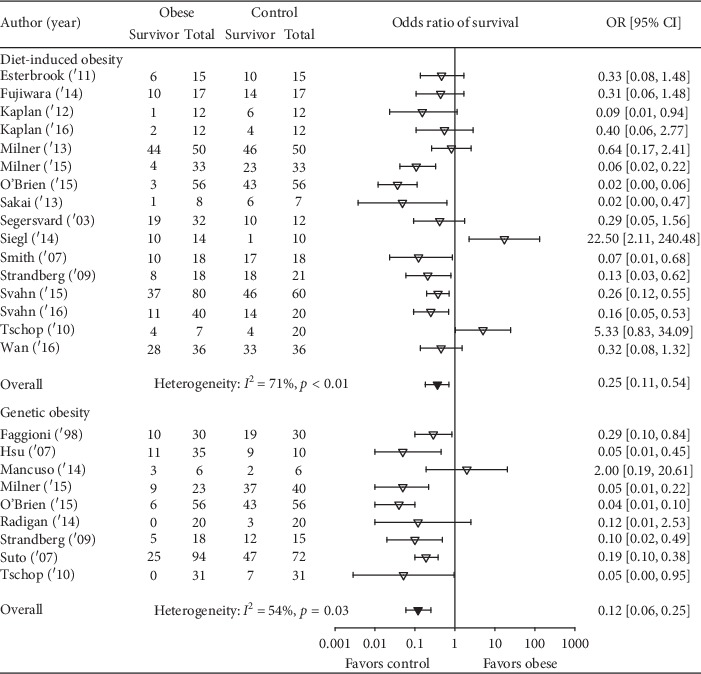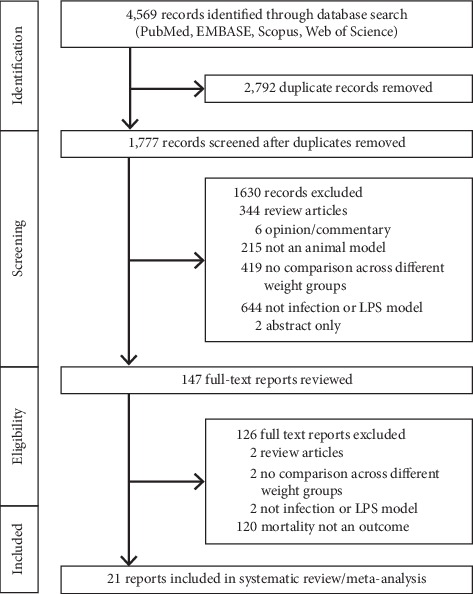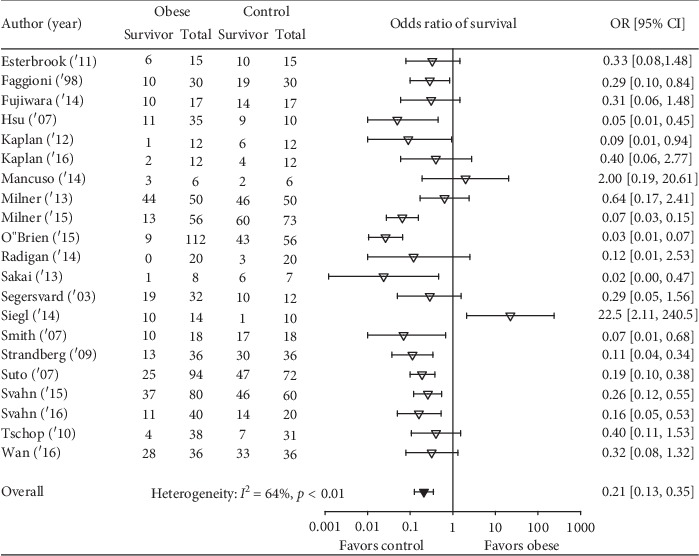The Effects of Obesity on Outcome in Preclinical Animal Models of Infection and Sepsis: A Systematic Review and Meta-Analysis.
IF 3.8
Q2 ENDOCRINOLOGY & METABOLISM
引用次数: 8
Abstract
Background Clinical studies suggest obesity paradoxically increases survival during bacterial infection and sepsis but decreases it with influenza, but these studies are observational. By contrast, animal studies of obesity in infection can prospectively compare obese versus nonobese controls. We performed a systematic review and meta-analysis of animal investigations to further examine obesity's survival effect in infection and sepsis. Methods Databases were searched for studies comparing survival in obese versus nonobese controls. We performed a systematic review and meta-analysis of animal investigations to further examine obesity's survival effect in infection and sepsis. Methods. Databases were searched for studies comparing survival in obese versus nonobese animals following bacteria, lipopolysaccharide, or influenza virus challenges. Results Twenty-one studies (761 obese and 603 control animals) met the inclusion criteria. Obesity reduced survival in 19 studies (11 significantly) and the odds ratio (95% CI) of survival (0.21(0.13, 0.35); I2 = 64%, p < 0.01p < 0.01p < 0.01) but with high heterogeneity. Obesity reduced survival (1) consistently in both single-strain bacteria- and lipopolysaccharide-challenged studies (n = 6 studies, 0.21(0.13, 0.34); I2 = 64%, p < 0.01p < 0.01) but with high heterogeneity. Obesity reduced survival (1) consistently in both single-strain bacteria- and lipopolysaccharide-challenged studies (n = 6 studies, 0.21(0.13, 0.34); I2 = 64%, p < 0.01p < 0.01) but with high heterogeneity. Obesity reduced survival (1) consistently in both single-strain bacteria- and lipopolysaccharide-challenged studies (n = 6 studies, 0.21(0.13, 0.34); I2 = 64%, p < 0.01p < 0.01) but with high heterogeneity. Obesity reduced survival (1) consistently in both single-strain bacteria- and lipopolysaccharide-challenged studies (n = 6 studies, 0.21(0.13, 0.34); I2 = 64%, p < 0.01p < 0.01p < 0.01) but with high heterogeneity. Obesity reduced survival (1) consistently in both single-strain bacteria- and lipopolysaccharide-challenged studies (n = 6 studies, 0.21(0.13, 0.34); I2 = 31%, p=0.20 and n = 5, 0.22(0.13, 0.36); I2 = 0%, p=0.59, respectively), (2) not significantly with cecal ligation and puncture (n = 4, 0.72(0.08, 6.23); I2 = 75%, p < 0.01), and (3) significantly with influenza but with high heterogeneity (n = 6, 0.12(0.04, 0.34); I2 = 73%, p < 0.01). Obesity's survival effects did not differ significantly comparing the four challenge types (p=0.49). Animal models did not include antimicrobials or glycemic control and study quality was low. Conclusions Preclinical and clinical studies together emphasize the need for prospective studies in patients accurately assessing obesity's impact on survival during severe infection.



肥胖对感染和败血症临床前动物模型结局的影响:系统回顾和荟萃分析
背景:临床研究表明,肥胖矛盾地增加了细菌感染和败血症的生存率,但降低了流感的生存率,但这些研究是观察性的。相比之下,在感染中肥胖的动物研究可以前瞻性地比较肥胖和非肥胖的对照。我们对动物研究进行了系统回顾和荟萃分析,以进一步研究肥胖对感染和败血症的生存影响。方法:检索数据库,比较肥胖与非肥胖对照组的生存率。我们对动物研究进行了系统回顾和荟萃分析,以进一步研究肥胖对感染和败血症的生存影响。方法。数据库检索了比较肥胖动物与非肥胖动物在细菌、脂多糖或流感病毒攻击后存活率的研究。结果:21项研究(761只肥胖动物和603只对照动物)符合纳入标准。肥胖降低了19项研究的生存率(11项显著),生存率的优势比(95% CI)为0.21(0.13,0.35);我2 = 64%,p < 0.01 p < 0.01 p n = 6研究,0.21 (0.13,0.34);我2 = 64%,p < 0.01 p n = 6研究,0.21 (0.13,0.34);我2 = 64%,p < 0.01 p n = 6研究,0.21 (0.13,0.34);我2 = 64%,p < 0.01 p n = 6研究,0.21 (0.13,0.34);我2 = 64%,p < 0.01 p < 0.01 p n = 6研究,0.21 (0.13,0.34);I 2 = 31%, p=0.20, n = 5, 0.22(0.13, 0.36);1 2 = 0%, p=0.59),(2)盲肠结扎和穿刺无显著性差异(n = 4, 0.72(0.08, 6.23);i2 = 75%, p < 0.01),(3)与流感有显著相关性,但异质性较高(n = 6, 0.12(0.04, 0.34);i2 = 73%, p < 0.01)。肥胖对生存的影响在四种攻击类型之间没有显著差异(p=0.49)。动物模型不包括抗菌剂或血糖控制,研究质量较低。结论:临床前和临床研究共同强调,需要对患者进行前瞻性研究,准确评估严重感染期间肥胖对生存的影响。
本文章由计算机程序翻译,如有差异,请以英文原文为准。
求助全文
约1分钟内获得全文
求助全文
来源期刊

Journal of Obesity
ENDOCRINOLOGY & METABOLISM-
CiteScore
7.50
自引率
3.00%
发文量
19
审稿时长
21 weeks
期刊介绍:
Journal of Obesity is a peer-reviewed, Open Access journal that provides a multidisciplinary forum for basic and clinical research as well as applied studies in the areas of adipocyte biology & physiology, lipid metabolism, metabolic syndrome, diabetes, paediatric obesity, genetics, behavioural epidemiology, nutrition & eating disorders, exercise & human physiology, weight control and health risks associated with obesity.
 求助内容:
求助内容: 应助结果提醒方式:
应助结果提醒方式:


